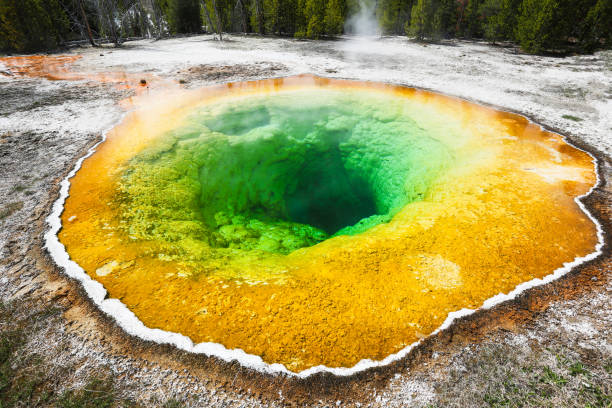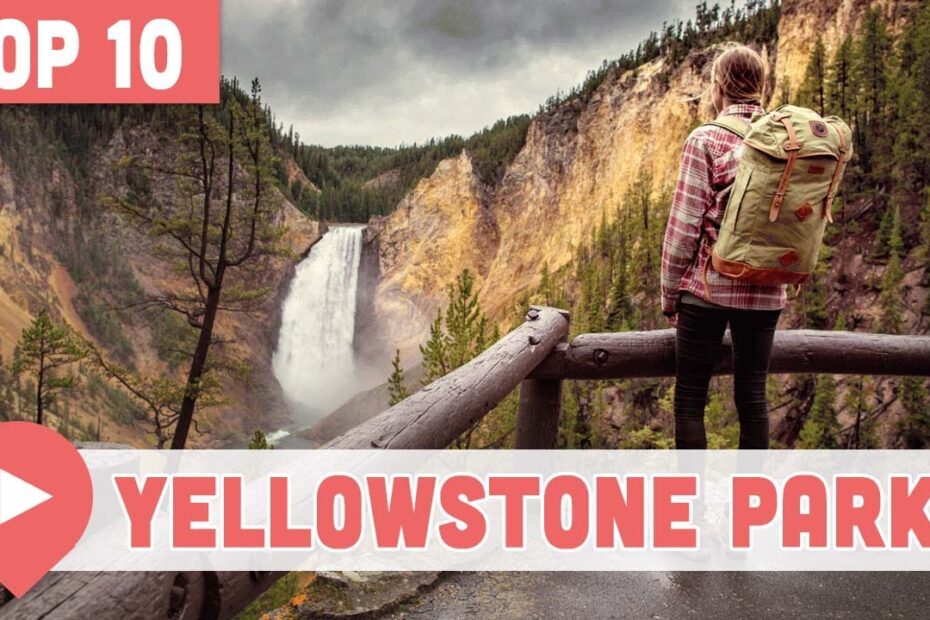Yellowstone is the 6th most popular national park in the United States, attracting at least 4 million visitors per year. Its natural beauty and wide range of attractions keep visitors coming back.
Every type of traveler will find plenty of things to do in Yellowstone National Park. There are hiking trails for adventurous trekers, wildlife viewing spots for animal-lovers, and gorgeous views for those who want to soak in as much natural beauty as possible.
Like and subscribe to Viewcation for more on visiting these amazing landmarks. Watch our video to learn about the top 10 things to do in Yellowstone National Park.

Old Faithful
Old Faithful may be the most well-known landmark in all of Yellowstone. It was the first of nearly 500 geysers to receive a name during the Washburn-Langford-Doane Expedition in 1870, 2 years before it was established as a national park in 1872.
Old Faithful erupts about every 90 minutes. Its regular schedule makes it one of the easiest geysers to spot while it’s active, but be patient if you’re too early or too late. You’ll have plenty of time to gape and take pictures once it erupts.
Old Faithful attracts large crowds, but they tend to be spread out and there’s plenty of parking available around this popular landmark.
Check the park schedule to see when the geyser is expected to erupt. You can arrive at any of the times listed, but if you want to sit on the benches in the front row, try to arrive at least 20-30 minutes early.
Grand Prismatic Spring
Grand Prismatic Spring is located in the Midway Geyser Basin. It’s the largest hot spring in the United States and the 3rd largest in the world. The only way to truly understand its massive scope and the beauty of its rainbow waters is to see it for yourself.
Grand Prismatic Spring contains layers of heat-loving bacteria that provide its magnificent colors. It’s blue at the center with green and yellow tints around that and orange on the outer layers.
The Grand Prismatic Spring is wheelchair-accessible, and its boardwalk gives you a view of other beautiful Yellowstone sights such as Excelsior Geyser and both the Opal and Turquoise Pool.
The area around the spring provides no shade and tends to be windy. Bring a sun hat to protect yourself, but be sure it has a strap so that it doesn’t fly away and pollute the natural beauty of this important landmark.
Get a view of the springs from above if you can. Use the Grand Prismatic Spring viewing platform that opens in late May. It’s accessible via a 1.2-mile hike through the Fairy Falls trail.
Carve out 1-2 hours for the trip. Either come with a tour or park your own car at the Grand Prismatic Spring parking lot at the Midway Geyser Basin. Visit early in the morning or late at night to avoid the crowds. Choose a clear, sunny day to see the brightest colors that the Grand Prismatic Spring has to offer.
Lamar Valley
Lamar Valley is one of the best places to visit in Yellowstone if you’ve come to the park to see wildlife. It contains herds of up to thousands of wild bison. You’ll also see plenty of other wild animals such as elk, deer, bears, coyotes, wolves, and more.
The Lamar Valley is located 70 miles from Old Faithful and remote enough that you have to take a 2-hour drive to get there. Bringing your car with you provides a more complete experience.
Carve out at least half a day to drive throughout the entire valley. Start in the early morning or late afternoon for the best chance to see wildlife. You can also join an organized 2 or 4-day trip that will take you through Lamar Valley and other popular Yellowstone landmarks.
The Grand Canyon of Yellowstone
The Grand Canyon of the Yellowstone River was rated #1 on Trip Advisor’s list of things to do in Yellowstone National Park. It’s over 24 miles long and 4,000 feet wide and reaches 1,200 feet deep in some areas.
Lookouts and walking trails provide the best view of the canyon. It can take up an entire day or a few hours depending on how much you want to see.
There are several major viewpoints along the Grand Canyon of Yellowstone. Start early in the morning and visit the most popular spots first to make sure you get to see them all before the crowds roll in.
Make sure to stop by Artist Point, the lookout along the South Rim. It provides a great view of the canyon and its famous Lower Falls. You may even see a rainbow there if you visit it on a summer morning. Spend any extra time you have driving to other points of interest such as Inspiration Point and the Brink of the Upper Falls.
The Grand Canyon also offers plenty of options for fans of hiking. Uncle Tom’s Trail contains 300 steps that bring you deep into the canyon. You can also hike along the North and South Rim of the canyon or try the 2.7-mile Point Sublime Trail. A guided hiking tour will take you to the best spots, and having a guide is helpful because bears live around the Canyon.
Hayden Valley
Hayden Valley is another great place to see wildlife in Yellowstone National Park. Visit in the early morning or late afternoon to see bears or herds of bison at their most active.
This is a popular landmark that attracts large crowds, and you may run into a bison traffic jam while visiting. Make sure to account for potential delays when deciding how long to spend in Hayden Valley during your trip to Yellowstone.
Like and subscribe for more on how to get the most out of your trips to our nation’s greatest natural wonders. Keep watching to learn about more of the best things to do in Yellowstone National Park, including spots to view wildlife, charming inns, and natural wonders.
Mammoth Hot Springs
Mammoth Hot Springs is split into the Upper and Lower Terraces. They’re connected by boardwalks, stairs, and a road called Terrace Drive. Its most notable features are Minerva Terrace, Palette Spring, Liberty Cap, and Canary Spring.
It’s possible to drive through the springs, but its small, congested parking areas make this difficult. Walking through it is a better option because it gives you a better look at each feature. It only takes about an hour, and you can stick to the lower trails if you want a less streneous experience. It’s also helpful to have your family or friends ready to pick you up at Terrace Drive when you’re finished experiencing everything the springs have to offer.
The temperatures of the Mammoth Hot Springs can be unbearable in the summer, so be sure to bring plenty of water and dress lightly if you’re visiting during the warmer months.
The Old Faithful Inn
The Old Faithful Inn was built in 1903 and is considered one of the largest log structures in the world.
Go to the outside terrace and bar on the first floor for a beautiful view of the Old Faithful geyser.
If you get hungry, try the Bear Pit Lounge instead of the inn’s main restaurant for shorter lines and reasonably priced food. A free, organized tour can help you understand the history of the lodge.
You don’t have to stay at the inn to get inside, but if you do, plan your stay 12-18 months in advance to ensure that there are still openings.
Yellowstone Lake
Yellowstone Lake is over 7,000 feet above the ground and holds the record of the largest high-elevation lake in North America. It freezes over in the winter and is too cold in the summer to swim in.
Unlike the other landmarks of Yellowstone, you’ll need to explore this one by boat. Join a boat or kayak tour or bring your own vessel. You can go fishing or simply enjoy the beautiful water.
If you’re not much for sailing or fishing, you can hike the trails on the shores instead.
You can also visit the nearby Lake Yellowstone Hotel. It was built in 1891 and is the oldest lodge in Yellowstone. Similar to the Old Yellowstone Inn, you can visit anytime but will have to book a stay over a year in advance.
The Grizzly and Wolf Discovery Center
This center, located in West Yellowstone outside of the West Entrance, houses animals that can’t survive in the wild. It rescues them from areas as close as Yellowstone itself to as far away as Alaska. There are currently 7 bears and 5 wolves, a Karelian bear dog, and a few birds of prey living here.
The Discovery Center is open 24/7 all year, and the bears that live there don’t hibernate. This means that you can visit at any time. Admission tickets are valid for 2 days, so you can visit twice if you’d like.
Reserve at least 1-2 hours for each trip to the center. It may not provide as much of an up-and-close view of wildlife as some of the other Yellowstone attractions, but it’s still a worthwhile, educational experience.
Boiling River
Boiling River is one of the most underrated but worthwhile things to do in Yellowstone National Park. It’s a natural hot tub created where hot springs meet a river and their warm and cold water converge. It’s closed in the spring, but be sure to give it a chance if it’s open.
Boiling River offers bathrooms where you can change into something more comfortable before getting in. Carve out at least an hour to get the full experience.
Saving this landmark for the end of your trip is a great way to relax if you’re tired from visiting all of Yellowstone’s other attractions.
The amount of things to do in Yellowstone National Park is staggering; it’s full of natural beauty, wild animals, charming historical buildings, and more. Knowing which of its many attractions are the best helps you plan the most memorable trip possible.
Have you visited any of the Yellowstone landmarks we mentioned? Let us know in the comments below. Like and subscribe to Viewcation for more on the places you need to see in America’s national parks.
